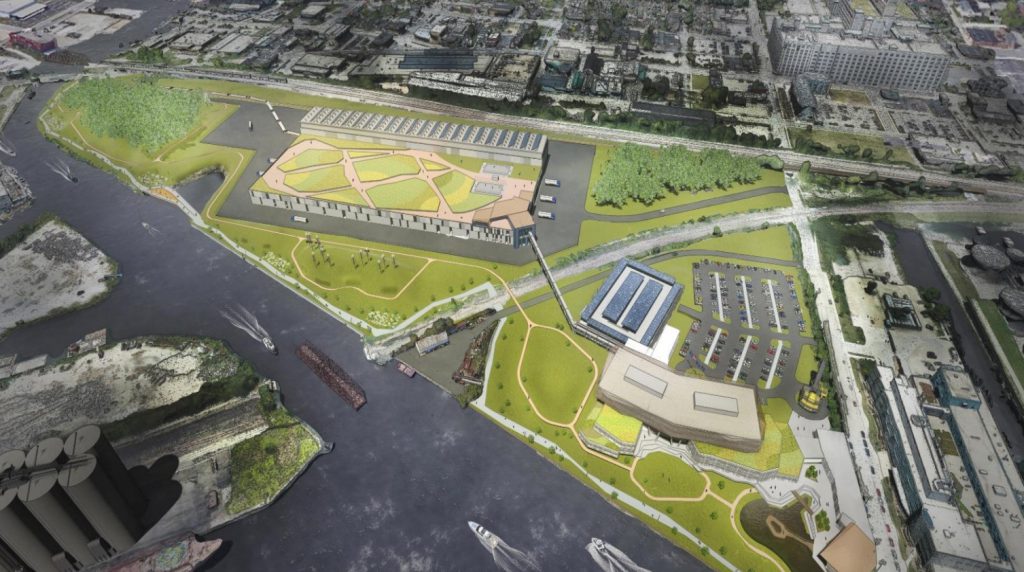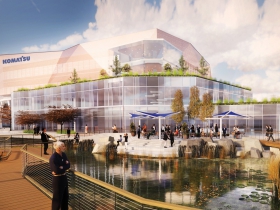America’s Largest Urban Manufacturing Proposal?
City Plan Commission approves land sale for $285 million deal with Komatsu company.
A proposal to create the largest urban manufacturing facility in the country had its first public hearing Monday afternoon.
The proposal is by Komatsu Mining, which is based in West Milwaukee, but whose huge parent company, Komatsu, is based in Tokyo. The proposed sale of a city-owned lot for Komatsu’s $285 million South Harbor Campus proposal came before the City Plan Commission.
Komatsu announced plans to relocate its mining equipment manufacturing campus from West Milwaukee to the city’s Harbor District in late September. “It’s arguably the most complex project I’ve worked on in all my years in city government,” said Department of City Development Commissioner Rocky Marcoux.
The city plans to sell almost all of its 13.56-acre lot located at the eastern end of Greenfield Ave. It would retain a 45-foot-wide strip (1.6 acres) along the harbor front for use as a riverwalk and potentially a cruise ship terminal. Space for a sidewalk (.3 acres) would also be retained along E. Greenfield Ave.
The city has an agreement to sell the land for $152,000 per acre, the same price We Energies will receive for its 45.96-acre site that is also part of the Komatsu proposal. The city will first need to spend approximately $500,000 to perform an environmental cleanup on the site. The site, acquired by the city in 1982, was long used for coal storage.
DCD economic development specialist Dan Casanova explained that part of We Energy’s cleanup involves the Kinnickinnic River. Similar to the city’s deal, the company would retain ownership of a 30-foot-wide strip running along the river and harbor to indemnify Komatsu against cleanup needs. A riverwalk would be built atop We Energy’s land.
The city will pay for both riverwalk segments, unlike its normal formula of paying for 70 percent of the riverwalk costs. On the We Energies site the city will not pay for any of the dockwall construction costs. The riverwalk would wrap around a 1.2-acre parcel that is not part of the development deal. The riverwalk would be designed to allow Komatsu to load materials from docked ships over it.
After nearly an hour discussing the myriad details involved in the broader proposal, the commission unanimously recommended the city move forward with the sale. The proposal will next go before the Common Council. The design and size of the buildings Komatsu intends to build are expected to comply with existing zoning, according to Casanova, and won’t be subject to city legislative approval.
A $40 million tax-incremental financing district to subsidize the project’s development and other neighboring infrastructure improvements is pending. That proposal will need Common Council approval, but is outside of the scope of the City Plan Commission. The state would also allocate up to $59 million in tax credits to the deal.
We Energies will also pay to lower the roadways under the bridge on E. Greenfield Ave. and the bridge on S. Kinnickinnic Ave. south of the Kinnickinnic River by one foot. The adjustments will allow truck traffic to access the site.
Komatsu intends to build a 410,000-square-foot manufacturing facility on the We Energies site. The city site, divided from the We Energies site by railroad tracks, would be used for a 170,000-square-foot office building and 20,000-square-foot company museum and training facility. The company hopes to relocate to the campus by 2022.
The Decline of Coal
Commissioner Whitney Gould questioned why the city would subsidize a coal mining equipment manufacturer. John Koetz, president of surface mining for Komatsu, said that Gould’s analysis of the decline of coal was correct, but that Komatsu’s business is increasingly not coal driven.
“More than two-thirds of our business is based on mining copper, iron ore and rare earth metals,” said Koetz. He waved his cell phone as an example of where the materials are going. “Our anticipation is alternative fuels will fuel growth for our business in the long term.”
Both Marcoux and Koetz referred to the proposal as the largest urban manufacturing proposal in the United States.
Casanova added that the city was worried when Komatsu purchased the longtime metro Milwaukee-company Joy Global, but the parent company’s broad portfolio has the potential to help it weather the cyclical nature of mining. Komatsu has 57,500 employees in 142 countries. The company manufactures equipment used for construction, mining, forestry and industrial machinery.
Its Komatsu Mining division has approximately 10,000 employees worldwide. The city incentives are based on estimates that the company will have at least 946 employees at the new site.
If you think stories like this are important, become a member of Urban Milwaukee and help support real independent journalism. Plus you get some cool added benefits, all detailed here.
Legislation Link - Urban Milwaukee members see direct links to legislation mentioned in this article. Join today
Related Legislation: File 181205
More about the Komatsu South Harbor Campus
- Construction Beginning On Milwaukee’s Largest-Ever Riverwalk Expansion - Jeramey Jannene - Jun 20th, 2025
- Eyes on Milwaukee: City Expands Vision For Harbor District Riverwalk - Jeramey Jannene - Sep 16th, 2022
- Eyes on Milwaukee: Inside Komatsu Mining’s Massive New Harbor District Campus - Jeramey Jannene - Jun 27th, 2022
- Eyes on Milwaukee: Planned Riverwalk Lets You Touch the Water - Jeramey Jannene - Nov 22nd, 2021
- Friday Photos: South Harbor Campus Rising Over Inner Harbor - Jeramey Jannene - Apr 30th, 2021
- Eyes on Milwaukee: SmithGroup Will Design Harbor District Riverwalk - Jeramey Jannene - Apr 30th, 2021
- Transportation: State To Fund Road, Rails for Komatsu - Jeramey Jannene - Mar 9th, 2021
- Eyes on Milwaukee: Who Wants To Design Harbor Riverwalk? - Jeramey Jannene - Mar 2nd, 2021
- Transportation: Railroad Expansion in the Harbor District - Jeramey Jannene - Feb 17th, 2021
- Friday Photos: Komatsu Mining Campus Takes Shape - Jeramey Jannene - Nov 6th, 2020
Read more about Komatsu South Harbor Campus here
Eyes on Milwaukee
-
Church, Cupid Partner On Affordable Housing
 Dec 4th, 2023 by Jeramey Jannene
Dec 4th, 2023 by Jeramey Jannene
-
Downtown Building Sells For Nearly Twice Its Assessed Value
 Nov 12th, 2023 by Jeramey Jannene
Nov 12th, 2023 by Jeramey Jannene
-
Immigration Office Moving To 310W Building
 Oct 25th, 2023 by Jeramey Jannene
Oct 25th, 2023 by Jeramey Jannene


























Who owns the 1.2 acre parcel not included, and what’s done there? Looks like scrap metal and rocks sitting on that parcel now…
The Kadinger family. They operate a marine service company from the site (Kadinger Marine Service). According to city records there a 4,000-square-foot building on the site.